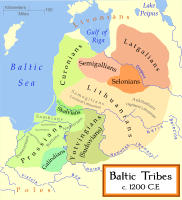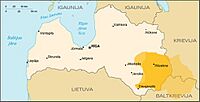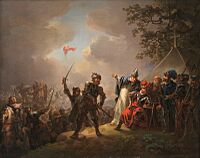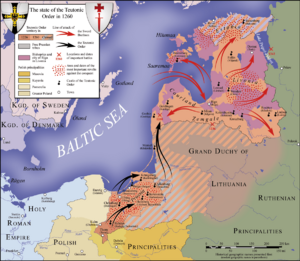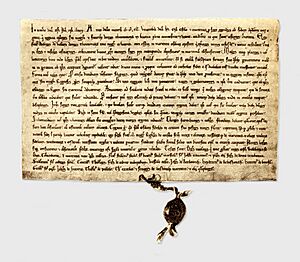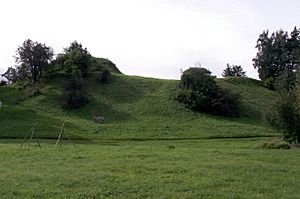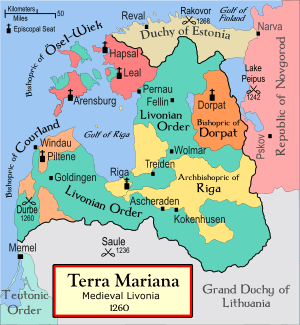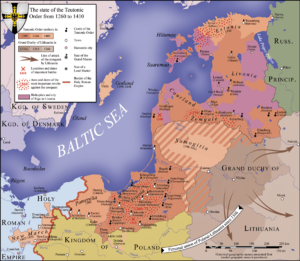Livonian Crusade facts for kids
Quick facts for kids Livonian Crusade |
|||||||||
|---|---|---|---|---|---|---|---|---|---|
| Part of the Northern Crusades | |||||||||
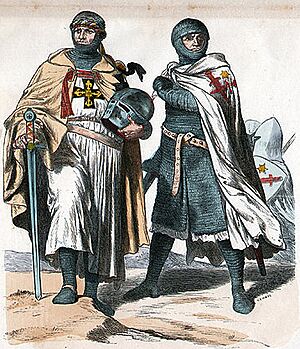 A Teutonic Knight on the left and a Swordbrother on the right. |
|||||||||
|
|||||||||
| Belligerents | |||||||||
|
Baltic pagans (indigenous peoples)
|
||||||||
| Commanders and leaders | |||||||||
|
|
||||||||
The Livonian Crusade was a series of military campaigns that took place in the lands of modern-day Latvia and Estonia during the 12th and 13th centuries. These campaigns were part of the larger Northern Crusades, which were approved by the Pope (the head of the Roman Catholic Church).
The main goal of the Livonian Crusade was to convert the local people, who followed pagan religions, to Christianity. The crusades were mostly led by groups from the Holy Roman Empire (a large empire in Central Europe) and the Kingdom of Denmark.
The crusade ended with the creation of new Christian states: Terra Mariana and the Danish Duchy of Estonia. The lands on the eastern side of the Baltic Sea were some of the last parts of Europe to become Christian. Much of what we know about this time comes from the Chronicle of Henry of Livonia.
In 1207, after some areas were conquered, a church-controlled state called Terra Mariana was formed. It was part of the Holy Roman Empire. In 1215, Pope Innocent III declared it was directly under the Holy See (the Pope's authority). Later, the conquered land was divided into six smaller areas by a church official named William of Modena.
Contents
Why Did the Crusades Happen?
In the late 1100s, German merchants started arriving in the eastern Baltic region. They came to trade along old routes. Some local people had already been baptized as Christians.
Meinhard of Segeberg arrived in Ikšķile (Üxküll) in 1184. His mission was to convert the Livonians, who were not Christian. He became the Bishop of Üxküll in 1186. Üxküll was an important center for these missionary efforts.
The Livonians often faced attacks from their southern neighbors, the Semigallians. At first, the Livonians saw the Germans as helpful allies. One of the first important Livonian leaders to convert was Caupo of Turaida, who was baptized around 1189.
In 1193, Pope Celestine III called for a crusade against non-Christians in Northern Europe. When peaceful ways of converting people didn't work, Meinhard tried to force the Livonians to convert, but he failed. He died in 1196.
His replacement, Bishop Berthold of Hanover, arrived in 1198 with many crusaders. Soon after, Berthold was killed, and his forces were defeated by the Livonians.
The Start of the Crusade (1198–1209)
To get revenge for Berthold's defeat, Pope Innocent III issued an order for a crusade against the Livonians. Albert von Buxthoeven became a bishop in 1199. He arrived the next year with a large army. In 1201, he made Riga the main city for his church area, called the Bishopric of Riga.
In 1202, Albert created the Livonian Brothers of the Sword. This group of knights helped convert pagans to Christianity. More importantly, they protected German trade and control over business in the area.
As the Germans gained more power, the Livonians and their Christian leader, Caupo, rebelled. Caupo's forces were defeated in 1206, and the Livonians were declared converted. Caupo then remained an ally of the crusaders until he died in the Battle of St. Matthew's Day in 1217.
By 1208, Albert's strong campaigns had captured important trading posts along the Daugava River. These included Salaspils (Holme), Koknese (Kokenhusen), and Sēlpils Castle (Selburg).
That same year, leaders of the Latgalian areas of Tālava, Satekle, and Autine made military agreements with the Livonian Brothers of the Sword. Construction began on stone castles like Cēsis Castle and Koknese Castle.
In 1209, Albert and his forces captured the main city of the Latgalian Principality of Jersika. They took the ruler Visvaldis's wife captive. Visvaldis had to give his kingdom to Albert, who then gave a part of it back to him as a fief (land granted in exchange for loyalty). Tālava became a vassal state (a state controlled by another) of the Archbishopric of Riga in 1214. It was fully divided between the Archbishopric and the Order in 1224.
-
Baltic tribes, around 1200.
Wars Against Estonians (1208–1227)
Conquering Estonian Lands
By 1208, the crusaders were strong enough to start fighting the Estonians. At that time, Estonia was divided into several counties, each led by elders. They didn't always work together closely.
With help from the newly converted Livs and Latgalians, the crusaders raided southern Estonia. The Estonian tribes fought back, sometimes attacking lands controlled by the crusaders.
From 1208 to 1227, armies from both sides fought across Livonia, Latgalia, and northern Estonia. The Livs, Latgalians, and troops from the East Slavic Republic of Novgorod sometimes helped the crusaders and sometimes the Estonians.
Important Hill forts (fortified settlements) were attacked and captured many times. A three-year truce (1213–1215) was made, which helped the German crusaders strengthen their power. The Estonians, however, couldn't unite their loose alliances into a strong state.
Their leader was Lembitu of Lehola, an elder from Sackalia. He became known to German writers as the main figure of Estonian resistance. In the Battle of St. Matthew's Day near Viljandi in 1217, the Livonian leader Caupo was killed. Lembitu was also killed, and the Estonians suffered a huge defeat.
Danish and Swedish Involvement
The Christian kingdoms of Denmark and Sweden also wanted to expand into the Baltic region. In 1218, Albert asked King Valdemar II of Denmark for help. Valdemar instead made a deal with the Livonian Order.
The Danish king won the Battle of Lindanise in Revelia in 1219. He then built a fortress called Castrum Danorum in Tallinn (Reval). The Estonians tried to capture it in 1220 and 1223 but failed.
King John I of Sweden tried to establish a Swedish presence in the province of Wiek. But his troops were defeated by the Oeselians in the Battle of Lihula in 1220. By then, all of northern Estonia was controlled by the King of Denmark.
During a major uprising in 1223, all Christian strongholds in Estonia, except Tallinn, fell to the Estonians. Their defenders were killed. By 1224, the crusaders had recaptured most large fortresses. Only Tartu (Dorpat) remained, defended by local troops and about 200 mercenaries from Novgorod. The crusaders finally captured Tartu in August 1224, killing all its defenders.
In 1224, the Holy Roman Emperor Frederick II declared that Livonia, Prussia, and other nearby areas would be directly under the Roman Catholic Church and the Holy Roman Empire. This meant they were not under local rulers. Later that year, Pope Honorius III appointed Bishop William of Modena as his special representative for these lands.
The Livonian Brothers of the Sword set up their main base at Fellin (Viljandi) in Sackalia in 1224. Other important strongholds included Wenden (Cēsis), Segewold (Sigulda), and Ascheraden (Aizkraukle).
The Chronicle of Henry of Livonia tells how William of Modena helped make peace between the Germans, Danes, and Vironians in 1226.
-
The Dannebrog falling from the sky during the Battle of Lindanise, 1219.
Fighting on Saaremaa (1206–1261)
The last Estonian area to resist the invaders was the island of Saaremaa (Ösel). Its war fleets continued to raid Denmark and Sweden during the crusades.
In 1206, a Danish army led by King Valdemar II tried to build a stronghold on Saaremaa but failed. In 1216, the Livonian Brothers of the Sword and Bishop Theodorich invaded Saaremaa across the frozen sea. The Oeselians fought back by raiding German-held lands in Latvia.
In 1220, a Swedish army captured Lihula in Western Estonia. The Oeselians attacked the Swedish stronghold later that year, killing everyone inside.
In 1222, the Danish king Valdemar II tried to conquer Saaremaa again. He built a stone fortress with a strong army. But the Oeselians surrounded it, and the Danes surrendered in five days. The Oeselians then destroyed the castle.
In 1227, the Livonian Brothers of the Sword, the city of Riga, and the Bishop of Riga launched a combined attack on Saaremaa. After the Muhu Stronghold was destroyed and the Valjala Stronghold surrendered, the Oeselians officially accepted Christianity.
After the Livonian Brothers of the Sword were defeated in the Battle of Saule in 1236, fighting started again on Saaremaa. In 1241, the Oeselians again accepted Christianity. They signed treaties with the Livonian Order and the Bishopric of Ösel-Wiek. Another treaty in 1255 gave the Oeselians special rights regarding land and religion.
War broke out again in 1261 when the Oeselians rejected Christianity and killed all the Germans on the island. A peace treaty was signed after the combined forces of the Livonian Order, the Bishopric of Ösel-Wiek, and Danish Estonia defeated the Oeselians. The Livonian Order then built a stone fort at Pöide.
On July 24, 1343, the Oeselians rose up again, killing all Germans on the island. They surrounded the Livonian Order's castle at Pöide. After the defenders surrendered, the Oeselians killed them and destroyed the castle. In 1344, Burchard von Dreileben led a campaign to Saaremaa. The Oeselians' stronghold was captured, and their leader Vesse was executed. Another campaign in 1345 ended with a treaty.
Saaremaa remained under the control of the Livonian Order and the Bishopric of Ösel-Wiek until 1559.
Wars Against Curonians (1242–1267)
After the Estonians were defeated, the crusade turned its attention to the Curonians and Semigallians. These were Baltic tribes living south and west of the Daugava River, closely allied with the Samogitians.
In July 1210, the Curonians attacked Riga. They couldn't break through the city walls. In 1228, Curonians and Semigallians attacked Riga again. They failed to storm the city but destroyed a monastery and killed all the monks.
After the Estonians were defeated in 1227, the Curonians faced enemies from Lithuania in the east and south. They were also harassed by the Livonian Brothers of the Sword from the north. In the west, the Danes and Swedes were waiting. Facing this difficult situation and a famine, the Curonians decided to make peace with the Christian conquerors. They invited monks into their country to avoid attacks from Scandinavian nations.
In 1230, the Curonians in northern Courland, led by their ruler Lammekinus, signed a peace treaty with the Germans. This area became known as Peace Courland. However, the southern Curonians continued to resist.
In 1260, the Curonians were forced to fight on the crusader side in the Battle of Durbe, one of the biggest battles in Livonia. When the battle began, the Curonians abandoned the knights. Some even attacked the knights from behind. The Estonians and other local people soon followed, leaving the knights. This allowed the Samogitians to win against the Livonian Order. This was a major defeat for the Order, leading to uprisings in Curonian and Prussian lands.
Curonian resistance finally ended in 1266. All of Courland was divided between the Livonian Order and the Archbishop of Riga. Curonian nobles, including 40 families of the descendants of the Curonian Kings, kept their personal freedom and some special rights.
Wars Against Semigallians (1219–1290)
According to the Chronicle of Henry of Livonia, the Semigallians first allied with Bishop Albert of Riga against rebellious Livonians before 1203. They received military help to stop Lithuanian attacks in 1205. In 1207, the Semigallian duke Viestards helped the Christian Livonian chief Caupo recapture his Turaida Castle from pagan rebels.
In 1219, the alliance between Semigallians and Germans ended after crusaders invaded Semigallia. Duke Viestards quickly formed an alliance with Lithuanians and Curonians. In 1228, Semigallians and Curonians attacked the Daugavgrīva monastery, a main crusader stronghold. The crusaders took revenge by invading Semigallia. The Semigallians then raided the land around the Aizkraukle hillfort.
In 1236, Semigallians attacked crusaders retreating to Riga after the Battle of Saule, killing many of them. After many attacks, the Livonian Order partly brought the Semigallians under control in 1254.
In 1270, the Lithuanian Grand Duke Traidenis, along with Semigallians, attacked Livonia and Saaremaa. During the Battle of Karuse on the frozen Gulf of Riga, the Livonian Order was defeated, and its master was killed.
In 1287, about 1400 Semigallians attacked a crusader stronghold in Ikšķile and looted nearby lands. As they returned, they were caught by the Order's forces. The great Battle of Garoza began near the Garoza river. The crusader forces were surrounded and badly defeated. More than 40 knights were killed, including the master of the Livonian Order. This was the last Semigallian victory against the growing power of the Livonian Order.
In 1279, after the Battle of Aizkraukle, Grand Duke Traidenis of Lithuania supported a Semigallian revolt against the Livonian Order, led by Duke Nameisis.
In the 1280s, the Livonian Order began a huge campaign against the Semigallians. They burned their fields, causing famine. The Semigallians continued to resist until 1290. They burned their last castle and moved south. Some historical accounts claim that 100,000 Semigallians moved to Lithuania and continued to fight against the Germans from there.
The southern parts of Curonian and Semigallian lands that were not conquered became part of the Grand Duchy of Lithuania.
What Happened After the Crusade?
In 1227, the Livonian Brothers of the Sword conquered all Danish lands in Northern Estonia. After the Battle of Saule, the remaining members of the Brothers of the Sword joined the Teutonic Order in Prussia in 1237. They became known as the Livonian Order.
On June 7, 1238, by the Treaty of Stensby, the Teutonic knights returned the Duchy of Estonia to Valdemar II. However, in 1346, after the St. George's Night Uprising, these lands were sold back to the Order and became part of the Ordensstaat.
After the conquest, all the local people were officially converted to Christianity. In 1535, the first book in the native language, a Christian catechism, was printed. The conquerors kept military control through their network of castles across Estonia and Latvia.
The land was divided into six main areas by the Pope's representative, William of Modena: the Archbishopric of Riga, the Bishopric of Courland, the Bishopric of Dorpat, the Bishopric of Ösel-Wiek, the lands ruled by the Livonian Brothers of the Sword, and the Dominum directum (direct rule) of the King of Denmark in the Duchy of Estonia.
See also
- Livonian Chronicle of Henry
- Wendish Crusade
- Baltic paganism


